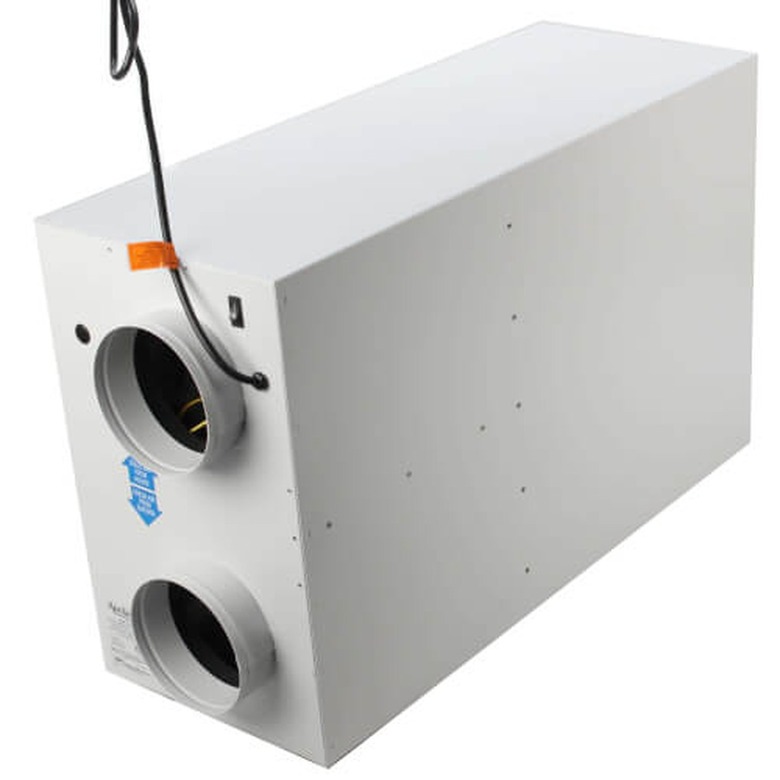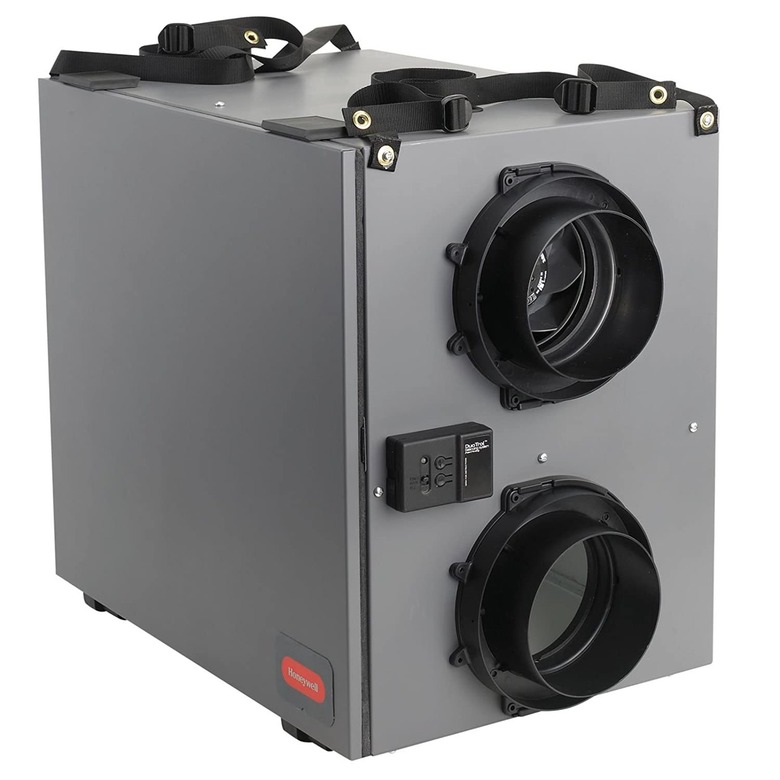How Much Does It Cost To Install An Air Exchanger?
We may receive a commission on purchases made from links.
Homes built to conform to the most recent building codes are so tightly sealed that an air exchanger is almost a necessity to move stale air out of the living space and replace it with fresh air. Unlike other methods of doing this, such as opening windows or running exhaust fans, an air exchanger produces a balanced stream of air that maintains the air pressure inside the home at a comfortable level, and an air exchanger that includes a heat exchanger — which is most of them — also helps to regulate temperature and even humidity.
If your home doesn't already have one, you may be wondering what it takes to install an air exchanger, and the answer depends on a number of factors, including the size of your home and how well it is sealed, your climate zone and the nature of your current HVAC system. This home improvement project isn't normally something a homeowner can DIY, and as far as pricing is concerned, it's impossible to specify a number without a professional inspection of your particular situation. As with any big-ticket home upgrade, it's important to get quotes from at least three different contractors. Depending on expertise and experience, quotes are likely to vary by a wide margin.
Tip
The average cost to install an air exchanger is a little over $3,000, but that's only a ballpark figure. The actual cost depends on the size and configuration of your house, whether you install a stand-alone system or one integrated with your current HVAC system and other factors.
Do You Need Humidity Control?
Do You Need Humidity Control?
The most popular heat exchanger on the market is the heat recovery ventilator (HRV), a rectangular metal box that mounts on the basement wall or ceiling. It allows the fresh air coming from outdoors to absorb heat from the stale indoor air being exhausted without the two air streams actually touching. An energy recovery ventilator (ERV) is a variation that also allows the air streams to exchange moisture. The main difference between an HRV and an ERV is the nature of the core, where the air streams actually mix. An HRV has a metal core, while the core of an ERV is made of a moisture-absorbent, paperlike material.
Homeowners in very humid or very dry climates or those who engage in activities that increase indoor humidity, such as cooking, are better off with a humidity-regulating ERV, and in terms of cost, there isn't much difference between that and an HRV. A smaller HRV capable of servicing a single room costs a little over $200, while a quality whole-house unit costs between $600 and $1,100. The same is basically true for ERVs, although a top-of-the-line model may cost $150 to $200 more. In terms of energy costs to run the units, there is virtually no difference between the two, but an HRV needs slightly more maintenance because its metal core can become moldy if it is not cleaned periodically.
New vs. Existing Ductwork for an Air Exchanger
New vs. Existing Ductwork for an Air Exchanger
Homeowners have two options when it comes to installing the ductwork for an air exchanger. The first is to install it as a stand-alone unit with its own ductwork, and the second is to incorporate it into the existing HVAC system and take advantage of the existing ductwork. Installation costs may be lower for the second option, but that doesn't necessarily make it the better one because there are some drawbacks.
The main drawback is that when the air exchanger fan is coupled with the blower motor for the gas furnace, air conditioner or heat pump (which is common), the air exchanger comes on only when the entire system is running. Because the air exchanger fan doesn't run full time, it has to move more air when it is running, so you need a bigger, more powerful and more expensive unit. Even if the air exchanger and HVAC system run independently, you still need a bigger unit because the HVAC ducts are bigger than those you would use for a stand-alone unit, and the fan has to blow more air to maintain the airflow. The coupled system also consumes more energy when it's running than either system would on its own.
In terms of installation, however, coupling an air exchanger with the existing heating system or cooling system is less expensive than installing all new ductwork for a stand-alone unit. The cost for ductwork installation depends on the size of the house and number of walls you have to tear into to install it. When coupling to an existing system, you only have to install the ducts that connect the air exchanger to the air return plenum, which costs a fraction of what it costs to install new ducts.
Cost of New Air Exchanger Ductwork
Cost of New Air Exchanger Ductwork
The average cost for ductwork installation is $35 to $55 per linear foot, which amounts to a total cost between $1,000 and $5,000 for an average-size home requiring 30 to 90 linear feet of ducting. That's really just a base estimate for conventional sheet metal ducting, however, and because air exchangers pose no threat of high temperatures or the release of toxic gases, like carbon monoxide, you can use flexible ducting, which is less expensive and easier to install.
That greatly simplifies the installation process and can reduce costs to a range between $1.30 and $2.50 per linear foot. That could mean installation costs could be measured in hundreds rather than thousands of dollars if you have plenty of room in the basement to hang the ducts and if installing them behind walls requires minimal remodeling.
Whether you use flexible or rigid ducting, you have to take into account the extra work needed to remove and replace wall coverings, punch holes in walls for the vent inlets and outlets and remove or modify any existing ductwork that may be in the way. In a complex home that was built without room for a ductwork system, it can still cost thousands of dollars for installation even if you use flexible ducting. In some jurisdictions, you may need a permit, which is an extra expense, and you should always read your homeowners' insurance policy to make sure that installing an air exchanger doesn't invalidate the policy warranty.
Integrating an Air Exchanger and HVAC System
Integrating an Air Exchanger and HVAC System
When added to an existing HVAC system, an air exchanger can make the system more energy efficient and can improve indoor comfort by feeding conditioned outdoor air into the return plenum, and it eliminates the need for a new duct system. The savings in installation costs are offset somewhat by the cost of the larger unit you need for such an application — which can be as much as $1,000 more than a smaller one — and the controls for a coupled system are more complex than those for a stand-alone one and also add to the cost.
Whole-house ventilation is an effective way to purify indoor air and remove pollutants, but it makes sense only if the house is tight enough. If air can pass through gaps in the floor, walls and ceiling, the ventilator blower will simply suck air through these gaps and recirculate it. An older home might not be a good candidate for a large air exchanger, but it might benefit from a smaller unit that serves the bathroom and kitchen, which are the rooms in the house where humidity is most problematic.

